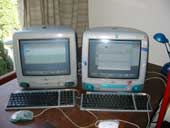 Over
Over
the last couple of days I’ve been experimenting a bit with different
backup methods. To begin, I did try out ExecutiveSync and its
successor You Syncronize but they are very, very
slow. Not only did the first synchronizing of a 0.5 Gb Folder between
two computers over our Airport-network took over 2.5 hrs, but also on
subsequent syncs the checking of the database seems to last forever.
So I turned to the fink project
again and did find two interesting packages : wget . GNU Wget is a free network utility to
retrieve files from the World Wide Web using HTTP and FTP, so one way
to backup a folder would be to put it in the Sites folder and
mirror it over the network using wget. I did’t check this out in
great details (did a small test to see it working but I assume it will
be slow for large folders). The other one is rsync It uses the “rsync algorithm” which
provides a very fast method for remote files into sync. It does this by
sending just the differences in the files across the link, without
requiring that both sets of files are present at one of the ends of the
link beforehand. This seems to be precisely what I wanted to do and
after a google for ‘rsync OS X’ I arrived at the RsyncX package which is an implementation of rsync
with HFS support and configuration through a command line (Terminal) or
graphical user interface. I downloaded this package and the GUI seems to
be placed in the Applications/Utilities and tried it out by
filling out the Source and Local Folders and pressing the synchronize
button. Not much progress was reported but the Activity Monitor
showed that it was using up all of the CPU so I was patient for over an
hour and then looked for the Network Activity in the Activity
Monitor and virtually no packets were going in or out, so I killed
RsyncX. I am sure I did something wrong but rather than trying to
get it working, I tried the command-line rsync-command I
downloaded from Fink. After a few false attempts I
typed
/sw/bin/rsync -a -e ssh iMatrixLieven.local:/Users/lieven/Documents /Users/lieven/docsLieven
and suddenly the packets were flying
happily over the network at 250 Kb/sec, so it took me only half an hour
to get a first synchronization done and subsequent changes are added in
no time! Afterwards I discovered that rsync is included in the
standard OS X Developers Tools as RsyncX seems to have replaced
it to rsync_orig and installed a new (quite large) rsync
in /usr/bin. Maybe my problems with RsyncX were caused
because I have /sw/bin earlier in my $PATH than
/usr/bin but verifying this will have to await another day. For
the moment, I’m happy to have a quick syncronizing tool available and
Real Madrid is playing on the TV…
 Again I
Again I